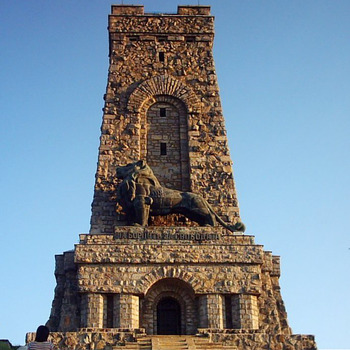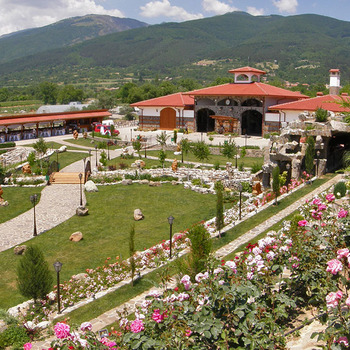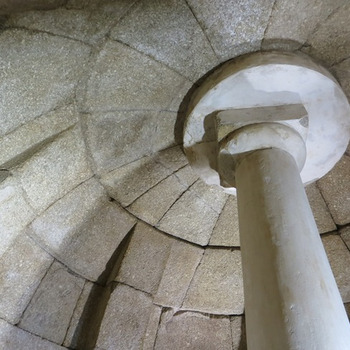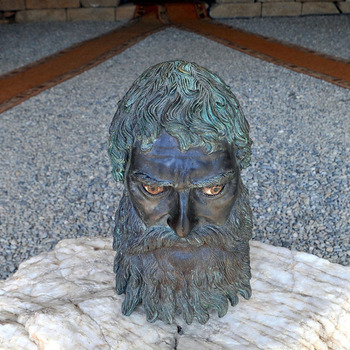The Ostrusha tomb-cult complex
Overview
The Ostrusha tomb-cult complex was discovered under the mound of the same name near the town of Shipka (Stara Zagora District) in April 1993 by the Bulgarian archaeologist Georgi Kitov. The complex was built in the middle of the IV century BC. and functioned as a temple to the Thracian god of immortality Sabazios until the 4th century AD. With its size and planning solution, the burial facility ranks among one of the most remarkable architectural achievements in Thrace and the Valley of the Thracian rulers (along with Golyama Kosmatka, Shushmanets and Golyama Arsenalka).
The complex is located on an area of 100 square meters and consists of five rectangular and one round room. The tomb is built of 2 monolithic stone blocks with a total weight of 60 tons. The first block is in the shape of a cube, in which the burial chamber is located, and the roof structure is made of the other. Of particular interest is the ceiling of the tomb - in the precisely carved ornaments can be seen portraits of people and figures of animals and flowers.
A horse skeleton, weapons, a silver jug, silver ornaments (applications) for horse ammunition, a phial, coins of Philip II of Macedon, ceramic vessels and other objects of high artistic value were found in the mound.
On April 13, 1993, Georgi Kitov's team discovered the central chamber of the burial facility, which is located on the southern periphery of the embankment and faces south. The temple consists of six chambers, which are located on an area of 100 m2. The facility is made of very well worked stone blocks, firmly welded through iron brackets filled with lead. The first uncovered room served as a distribution point to the chambers located on the east, west and north sides of the temple. The chamber, located on the east side, was found with a ruined domed roof and individual horse bones scattered on the floor. The camera located on the southwest side of the complex is the only one found intact. The northeastern and northwestern chambers are smaller in size, with no entrances, and access to them was probably via stairs, with Kitov suggesting that they were used as a kind of gift box, which was carefully emptied during the robbery of the tomb.
Of great scientific interest is the central monolithic chamber, which is made of a stone block weighing 60 tons, in which is carved the room, which is placed on a three-stage stereobat, which is attached by a lead filling. The roof-cover is identical. All other rooms are fused to the stereo, which indicates that for some time he and the central camera were standing alone. The entrance is carved on the south side of the building, and under the gables and the gable roof are left toothed protrusions that mimic wooden joists. A ritual stone bed with plastic ornamentation and railings is installed in the chamber opposite the entrance. The ceiling has an imitation of wooden beams, which divide it into geometric shapes, and in the middle is formed a circular field, which performs the function of the sun. The rectangular and triangular fields around the so-called "Sun" on the ceiling are filled with plant and geometric decoration - scenes from the life of Thracian aristocrats, portraits and images of men and women, scenes with animals and plants, which were inlaid with gold, prevailed.
A skeleton of a horse in anatomical order was found at the southern end of the looted southwest chamber - probably sacrificed and buried here. The blade of a knife stuck in the animal's chest was found. Apart from the animal, in a cloth or leather bag in the northwest corner of the camera was placed the harness - an iron bridle, silver rings, silver applications with engraved zoomorphic images. Also found in the room - scattered pieces of two silver vessels (phial and jug), which resembles the so-called. "Wooden type" - observed in vessels from the Rogozen treasure.
In front of the entrance of the tomb, archaeologists found a symbolic sarcophagus-like tomb, and in front of it, in a straight line, are scattered six stone arches with plastic decoration of palmettes. Some of them were painted in pale blue and pale pink, and according to Georgi Kitov, no doubt decorated the pediment of the building. It seems that when the facility served in antiquity as a temple dedicated to Sabazios, some of the architectural details and inventory were dismantled and arranged to the south of the building, a phenomenon that is still difficult to explain to Thracians.
The temple, built in the early IV century BC. was used until the third quarter of the same century, and was completed in several stages - carving and installation of the central chamber, abandonment and backfilling of the facility. The stages are marked by a silver Apollonian obol and two coins of Philip II of Macedon, as well as silver ornaments for horse ammunition and parts of metal vessels.
During the early Byzantine era, the mound was used as a Christian necropolis. According to Kitov, the Byzantines, making analogies with their own sacred architecture, searched for the crypt under the burial chamber and, digging a tunnel, found themselves in the central chamber. Archaeologists have found several dozen coins from the time of Constantine the Great, pieces of comb pottery, shoe polish and a rare Persian silver coin. Probably after entering the central chamber, deceived by the gold inlays on the images and driven by their own religious intolerance of human images, they destroyed most of them.
The Ostrusha mound was used as a headquarters for Russian troops during the Russo-Turkish War of Liberation in 1877-78.
The frescoes from Ostrusha are precisely executed in blue, yellow, red and green with shades and were a masterpiece of the ancient Thracian fine art, and according to Georgi Kitov, their artistic value is indisputably greater than those depicted and perfectly preserved in the Kazanlak tomb.
Recommended
- Art Gallery Kazanlak
- Museum of History
- Kazanlak Monastery Presentation of the Blessed Virgin Mary
- Historical and ethnographic complex Kulata
- House-museum of acad. Dechko Uzunov
- Kazanlak tomb


 Bulgarian
Bulgarian Romanian
Romanian




